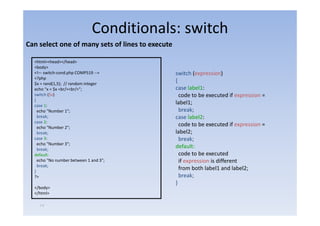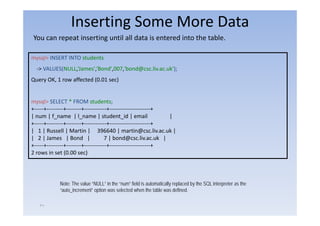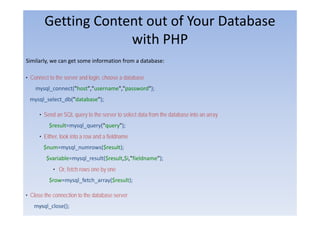PHP is a server-side scripting language commonly used for web development. It allows code to be embedded into HTML pages using tags. When a page request is received by the server, it will execute any PHP code, substitute the output into the HTML page, and send the resulting page to the client. PHP supports different data types including scalars like integers, floats and strings, as well as arrays to store multiple values.







![Arrays
y
An array in PHP is actually an ordered map. A map is a type that maps values to keys.
array() = creates arrays
<?php
$arr = array("foo" => "bar", 12 => true); key = either an integer or a string.
echo $arr["foo"]; // bar
echo $arr[12]; // 1 value = any PHP type.
?>
if no key given (as in example), the PHP
<?php
array(5 => 43, 32, 56, "b" => 12);
interpreter uses (maximum of the integer indices +
array(5 => 43, 6 => 32, 7 => 56, "b" => 12);
y( ) 1).
?>
if an existing key, its value will be overwritten.
<?php
p p
$arr = array(5 => 1, 12 => 2);
can set values in an array
foreach ($arr as $key => $value) { echo $key, ‘=>’,
$value); }
$arr[] = 56; // the same as $arr[13] = 56; unset() removes a key/value pair
$arr[ x ]
$arr["x"] = 42; // adds a new element
unset($arr[5]); // removes the element
unset($arr); // deletes the whole array
$a = array(1 => 'one', 2 => 'two', 3 => 'three');
array_values() makes reindexing effect
unset($a[2]); (indexing numerically)
$b = array_values($a);
l ($ )
?>
٨ *Find more on arrays](https://image.slidesharecdn.com/lecture8-110309150335-phpapp02/85/Lecture8-8-320.jpg)






![User Defined Functions
Can define a function using syntax such as the following:
<?php
function foo($arg 1, $arg 2, /* ..., */ $arg n)
($ g_ , $ g_ , / , / $ g_ ) Can also define conditional functions, functions
functions
{
echo "Example function.n";
within functions, and recursive functions.
return $retval;
}
?>
Can return a value of any type
<?php <?php
function square($num) function small_numbers()
{ {
return $num * $num; return array (0, 1, 2);
} }
echo square(4); list ($zero, $one, $two) = small_numbers();
?> echo $zero, $one, $two;
?>
<?php
function takes_array($input)
{
echo "$input[0] + $input[1] = ", $input[0]+$input[1];
$input[0]
}
takes_array(array(1,2));
?> ١۵](https://image.slidesharecdn.com/lecture8-110309150335-phpapp02/85/Lecture8-15-320.jpg)



![Server Variables
The $_SERVER array variable is a reserved variable that contains all server information.
<html><head></head>
h l h d /h d
<body>
<?php
echo "Referer: " . $_SERVER["HTTP_REFERER"] . "<br />";
_ [ _ ]
echo "Browser: " . $_SERVER["HTTP_USER_AGENT"] . "<br />";
echo "User's IP address: " . $_SERVER["REMOTE_ADDR"];
?>
</body>
</html>
The $_SERVER is a super global variable, i.e. it's available in all scopes of a PHP script.
١٩](https://image.slidesharecdn.com/lecture8-110309150335-phpapp02/85/Lecture8-19-320.jpg)


![Form Handling
Any form element is automatically available via one of the built‐in PHP variables (provided the element has a “name” defined with
y o e e e t s auto at ca y a a ab e a o e o t e bu t a ab es (p o ded t e e e e t as a a e de ed t
it).
<html>
<‐‐ form.html COMP519 ‐‐>
<body>
<form action="welcome.php" method="POST">
Enter your name: <input type="text" name="name" /> <br/>
Enter your age: <input type="text" name="age" / <br/>
" " " " /> b /
<input type="submit" /> <input type="reset" />
</form>
</body>
</html>
<html> $_POST
_
<!–‐ welcome.php COMP 519 ‐‐>
! l h
contains all POST data.
<body>
$_GET
Welcome <?php echo $_POST["name"].”.”; ?><br />
contains all GET data.
You are <?php echo $_POST["age"]; ?> years old!
</body>
</html>
٢٢](https://image.slidesharecdn.com/lecture8-110309150335-phpapp02/85/Lecture8-22-320.jpg)
![Cookie Workings
setcookie(name,value,expire,path,domain) creates cookies.
ki ( l i h d i ) ki
<?php
setcookie("uname", $_POST["name"], time()+36000);
?>
<html>
<body> NOTE:
<p> setcookie() must appear
Dear <?php echo $_POST["name"] ?>, a cookie was set on this
BEFORE <html> (or any output)
page! The cookie will be active when the client has sent the
cookie back to the server. as it’s part of the header
</p> information sent with the page.
</body>
</html>
<html>
<body> $_COOKIE
<?php contains all COOKIE data.
if ( isset($_COOKIE["uname"]) )
echo "Welcome " . $_COOKIE["uname"] . "!<br />";
else isset()
echo "You are not logged in!<br />"; finds out if a cookie is set
?>
</body>
</html>
/
use the cookie name as a variable
٢٣](https://image.slidesharecdn.com/lecture8-110309150335-phpapp02/85/Lecture8-23-320.jpg)



![Main Program
/*Main Program*/
if (!$_POST["submit"])
{
?>
<h3>Please enter your information</h3>
<p>Fields with a "<b>*</b>" are required.</p>
<?php
print_form("","","","");
}
else{
check_form($_POST["f_name"],$_POST["l_name"],$_POST["email"],$_POST["os"]);
}
?>
</body>
</html>
٢٧](https://image.slidesharecdn.com/lecture8-110309150335-phpapp02/85/Lecture8-27-320.jpg)




















![Student Database: data_in.php
<html>
<head>
<title>Putting Data in the DB</title>
</head>
<body>
<?php
/*insert students into DB*/
if(isset($_POST["submit"])) {
$db = mysql_connect("mysql”, ”martin");
mysql_select_db("martin");
$date=date("Y-m-d");
$d t d t ("Y d") /* G t th current date in the right SQL f
Get the t d t i th i ht format
t */
$sql="INSERT INTO students VALUES(NULL,'“ . $_POST[“f_name"] . "','“ .
$_POST["l_name"] . "',“ . $_POST["student_id"] . ",'“ . $_POST["email"] .
"','“ . $date . "',“ . $_POST["gr"] . ")"; /* construct the query
*/
mysql_query($sql); /* execute the query */
mysql_close();
echo"<h3>Thank you. The data has been entered.</h3> n";
echo'<p><a href="data_in.php">Back to registration</a></p>‘ . “n”;
echo'<p><a href "data out php">View the student lists</a></p>‘ .”n”;
href="data_out.php">View ”n”;
}
۴٨](https://image.slidesharecdn.com/lecture8-110309150335-phpapp02/85/Lecture8-48-320.jpg)



![Student Database: data_out.php
<?php
p p
/*get students from the DB */
$db = mysql_connect("mysql",“martin");
mysql_select_db(“martin", $db);
switch($_GET["order"]){
case 'date': $sql = "SELECT * FROM students ORDER BY date"; break;
case ‘student_id': $sql = "SELECT * FROM students ORDER BY student_id"; break;
case ‘l_name': $sql = "SELECT * FROM students ORDER BY l_name"; break;
default: $sql = “SELECT * FROM students”; break;
}
if(isset($_POST["submit"])){
$sql = “SELECT * FROM students WHERE gr=“ . $_POST["gr"];
}
$result=mysql_query($sql); /* execute the query */
while($row=mysql_fetch_array($result)){
echo "<h4> Name: “ . $row["l_name"] . ', ‘ . $row["f_name"] . "</h4> n";
echo "<h5> ID: “ . $row[“student_id"] . "<br/> Email: “ . $row["email"] . "<br/> Group: “ . $row["gr"] . "<br/> Posted:
“ . $row["date"] . "</h5> n";
}
mysql_close();
?>
</body>
</html>
۵٢](https://image.slidesharecdn.com/lecture8-110309150335-phpapp02/85/Lecture8-52-320.jpg)























![Processing the results of a query
• There
Th are two main PHP methods to f h the results of an SQL query, these b i
i h d fetch h l f h being
‘mysql_fetch_row()’ and ‘mysql_fetch_array()’.
<?php
// Assuming a database connection, and a valid query string.
$result = mysql_query( $query );
while ($result_row = mysql_fetch_row($result)) {
echo $result_row[2] . ‘<br/>’;
}
?>
The ‘mysql fetch row()’ command fetches the query results as an enumerated array
mysql_fetch_row()
(an array that uses numerical indices), one row at a time, returning FALSE when
there are no more rows (ending the ‘while’ loop in this case).
٧۶](https://image.slidesharecdn.com/lecture8-110309150335-phpapp02/85/Lecture8-76-320.jpg)
![Processing the results of a query (cont.)
• mysql_fetch_array can get a row of results as an associative array (using
strings as the array indices) It takes a result as its first parameter and an optional
indices). parameter,
second parameter as a way to bind the results in the array.
• If MYSQL_ASSOC is specified, the results are indexed using the column names in
the query. If MYSQL_NUM is specified, then the numerical array indices (starting
query MYSQL NUM specified
at zero) access the results. The default value MYSQL_BOTH returns an array with
both types.
while ( $row = mysql_fetch_array($result, MYSQL_ASSOC) ) {
echo $row[“title”] . ‘<br/>’;
}
• Using a statement like ‘mysql_fetch_array($result, MYSQL_NUM)’ is essentially
equivalent to the statement ‘mysql_fetch_row($result)’ as they both return arrays
stored with numerical indices
indices.
• The ‘mysql_fetch_array()’ command can be used to save memory by specifying,
say, MYSQL_ASSOC, instead of the default value.
٧٧](https://image.slidesharecdn.com/lecture8-110309150335-phpapp02/85/Lecture8-77-320.jpg)
